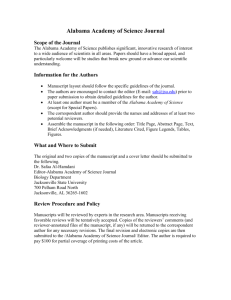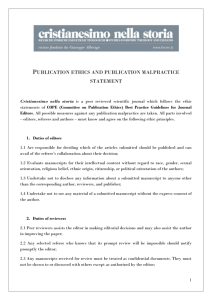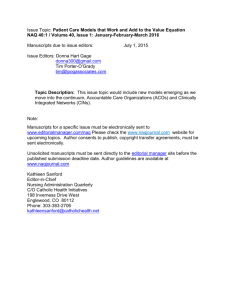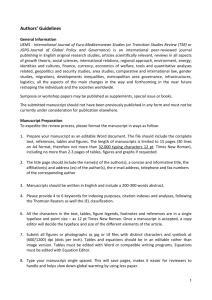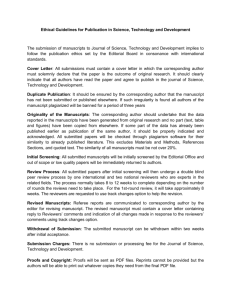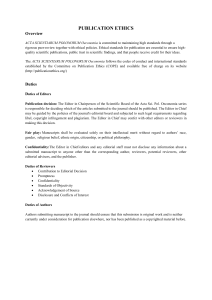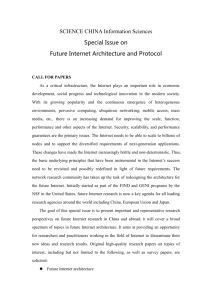FROM THE EDITORS RETHINKING MANAGEMENT SCHOLARSHIP
advertisement
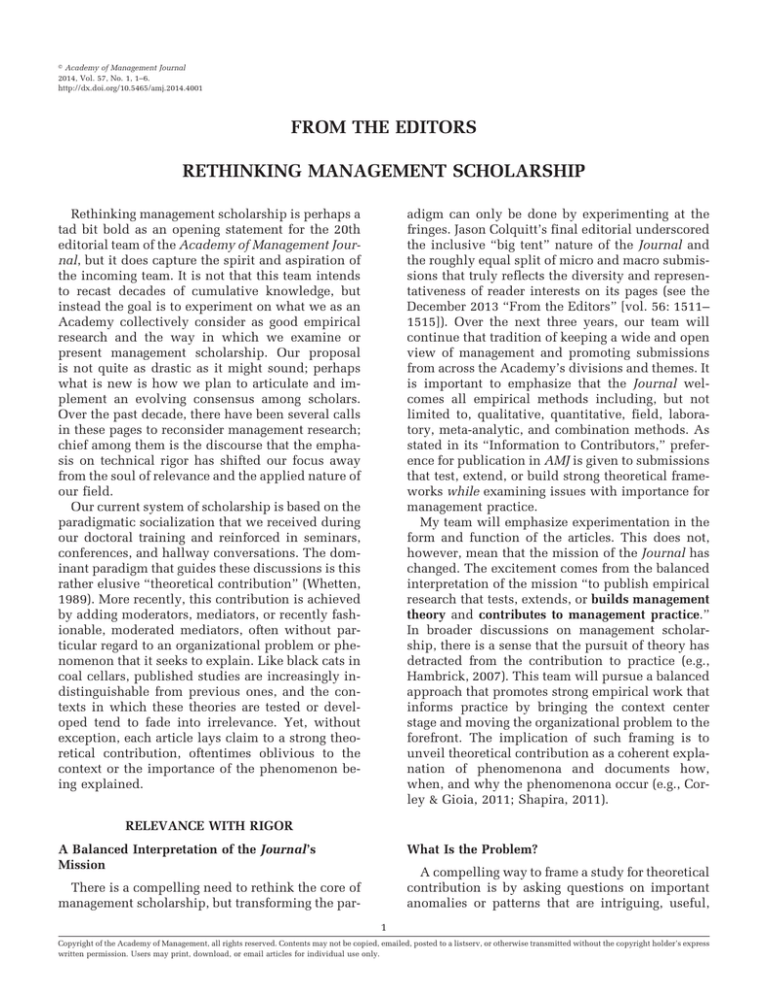
娀 Academy of Management Journal 2014, Vol. 57, No. 1, 1–6. http://dx.doi.org/10.5465/amj.2014.4001 FROM THE EDITORS RETHINKING MANAGEMENT SCHOLARSHIP Rethinking management scholarship is perhaps a tad bit bold as an opening statement for the 20th editorial team of the Academy of Management Journal, but it does capture the spirit and aspiration of the incoming team. It is not that this team intends to recast decades of cumulative knowledge, but instead the goal is to experiment on what we as an Academy collectively consider as good empirical research and the way in which we examine or present management scholarship. Our proposal is not quite as drastic as it might sound; perhaps what is new is how we plan to articulate and implement an evolving consensus among scholars. Over the past decade, there have been several calls in these pages to reconsider management research; chief among them is the discourse that the emphasis on technical rigor has shifted our focus away from the soul of relevance and the applied nature of our field. Our current system of scholarship is based on the paradigmatic socialization that we received during our doctoral training and reinforced in seminars, conferences, and hallway conversations. The dominant paradigm that guides these discussions is this rather elusive “theoretical contribution” (Whetten, 1989). More recently, this contribution is achieved by adding moderators, mediators, or recently fashionable, moderated mediators, often without particular regard to an organizational problem or phenomenon that it seeks to explain. Like black cats in coal cellars, published studies are increasingly indistinguishable from previous ones, and the contexts in which these theories are tested or developed tend to fade into irrelevance. Yet, without exception, each article lays claim to a strong theoretical contribution, oftentimes oblivious to the context or the importance of the phenomenon being explained. adigm can only be done by experimenting at the fringes. Jason Colquitt’s final editorial underscored the inclusive “big tent” nature of the Journal and the roughly equal split of micro and macro submissions that truly reflects the diversity and representativeness of reader interests on its pages (see the December 2013 “From the Editors” [vol. 56: 1511– 1515]). Over the next three years, our team will continue that tradition of keeping a wide and open view of management and promoting submissions from across the Academy’s divisions and themes. It is important to emphasize that the Journal welcomes all empirical methods including, but not limited to, qualitative, quantitative, field, laboratory, meta-analytic, and combination methods. As stated in its “Information to Contributors,” preference for publication in AMJ is given to submissions that test, extend, or build strong theoretical frameworks while examining issues with importance for management practice. My team will emphasize experimentation in the form and function of the articles. This does not, however, mean that the mission of the Journal has changed. The excitement comes from the balanced interpretation of the mission “to publish empirical research that tests, extends, or builds management theory and contributes to management practice.” In broader discussions on management scholarship, there is a sense that the pursuit of theory has detracted from the contribution to practice (e.g., Hambrick, 2007). This team will pursue a balanced approach that promotes strong empirical work that informs practice by bringing the context center stage and moving the organizational problem to the forefront. The implication of such framing is to unveil theoretical contribution as a coherent explanation of phenomenona and documents how, when, and why the phenomenona occur (e.g., Corley & Gioia, 2011; Shapira, 2011). RELEVANCE WITH RIGOR A Balanced Interpretation of the Journal’s Mission What Is the Problem? A compelling way to frame a study for theoretical contribution is by asking questions on important anomalies or patterns that are intriguing, useful, There is a compelling need to rethink the core of management scholarship, but transforming the par1 Copyright of the Academy of Management, all rights reserved. Contents may not be copied, emailed, posted to a listserv, or otherwise transmitted without the copyright holder’s express written permission. Users may print, download, or email articles for individual use only. 2 Academy of Management Journal and nonintuitive. In an earlier editorial with Jason Colquitt, I suggested that we need to explore “Grand Challenges” in management (see the June 2011 “From the Editors” [vol. 54: 432– 435]). The principle is to pursue bold ideas and adopt less conventional approaches to address significant, unresolved problems. Not all our studies understandably will be grand, nor will they all challenge conventional wisdom, but considering the relative importance and scale of a problem will likely make a study more relevant to managers, and make it more interesting for our readers. There are multiple ways by which manuscripts can be better positioned for a theoretical and empirical contribution using a problem focus (Alvesson & Sandberg, 2011; Pillutla & Thau, 2013; also see the October 2011 “From the Editors” [vol. 54: 873– 879]). What is important to recognize is that this team places emphasis on how a central research problem or question is articulated. Bringing organizational problems to the forefront would ease the burden on vaguely scripted “Managerial Implications” sections of manuscripts (Bartunek & Rynes, 2010). My editorial team will look for clearly articulated problem statements or research questions motivated by managerial challenges. This problem-based focus shifts the emphasis away from motivating articles using pure theories to tackling important problems through an enriched theoretical lens. For example, Hekman and colleagues (Hekman, Aquino, Owens, Mitchell, Schilpzand, & Leavitt, 2010) motivate their study on gender and racial biases in customer satisfaction surveys by emphasizing the importance of the managerial problem that a 1 percent change in customer satisfaction creates a 5 percent change in return on investment. Understanding the scale and scope of the problem and asking the right question takes primacy over the deftness of theoretical manipulation using constructs, moderators, and moderated mediators. We prefer manuscripts that emphasize how constructs provide a coherent explanation of the phenomenon rather than framing and motivating studies by adding untested moderators and mediators. Such an effort would rightly dissuade authors from identifying smaller “gaps” in the literature and shift the discussion to managerial, organizational, and societal problems that need to be addressed. Bringing the Context Back In How does the context shape the boundary conditions or assumptions of the theories being exam- February ined? Why is this context appropriate to test your theory? These queries often appear in letters to authors asking them to critically explore how and why the context shapes the theory—the responses to these queries often amplify the “interestingness” or “novelty” of a study itself. At the heart of these queries lies a fundamental assumption that context matters. Unfortunately, more than half the manuscripts that I receive do not motivate the study using the context. Often the sample is noted dismissively as a setting to test a specific theory. While there are exceptions where the causal theory is the core feature, for example in manipulations for lab experiments, most other field or case studies are enriched by the context in which they are studied. Studies that explain individual behavior are best positioned to take advantage of context; understanding an organization, its culture, its policies, and physical environment and how they might influence, for example, moods, emotions, actions, or behaviors. For example, Vashdi, Bamberger, and Erez (2013) integrate the context of surgical teams in hospitals into theories of action team learning. Similarly, macro studies that explain firm behavior in an industry can be better positioned by integrating industry characteristics into the motivation for the study. Authors could potentially use the setting to frame a problem that would not otherwise be salient. One manuscript for which I served as action editor was on the topic of stigma and disapproval of organizations in the global arms industry (Vergne, 2012). In the original version, the manuscript was written as a deductive study testing stigma in the arms industry. The original version had its merits, but the manuscript became much more interesting when the author integrated the richness of the context (global arms industry) into the framing of the arguments (public disapproval) and included interviews he had conducted to better understand the industry (mixed methods). The published version reflects a more nuanced understanding of a focal problem in an interesting context to inform a theory that would interest managers and scholars alike. Embedding Problems and Contexts The challenge with being an editor is that you are not the reviewer! An incoming editor might lay out a vision, but without consensus and guidance, the reviewers will likely revert to habit. Our team’s efforts in informing and educating reviewers will 2014 only slowly take hold as reviewers see editorial letters shaping manuscripts proactively. We have also taken additional steps that might help embed this philosophy. First, in the reviewer forms for each manuscript we have added a new criterion for evaluation as “Engages an important problem for organizations” against which reviewers would score on a scale from “inadequate” to “very strong.” To refresh the reader, other criteria include (1) theoretical contribution, (2) empirical contribution, (3) interestingness, innovativeness, and novelty, and (4) clarity of exposition. This additional criterion will, hopefully, trigger reviewer awareness of the centrality and importance of organizational problems to this editorial team. In addition, during the Editorial Review Board meeting at the Academy of Management conference in Orlando, I emphasized the importance of experimenting at the fringes in the structure of a paper as well as the way we formulate and test our research questions. Finally, our team will use editorials coauthored with a senior executive, thought leader, or scholar from a different field to explore new content areas and grand challenges, with the goal of expanding the scope, interestingness and relevance of the work presented in the Journal. The principle is to use the editorial notes as stage setters for further work and for opening up fresh new areas of inquiry. Over the next three years, this editorial team will also try to accommodate deviations from, and experimentation with, the “house style” to make our research more innovative and appealing to a broader membership. A GLOBAL TEAM FOR A GLOBAL ACADEMY Now that I have discussed the substance of the changes, it is time to introduce the team. The 20th editorial team size has increased to 18 associate editors (up from 13) to handle over 1,200 original submissions (1,600⫹ including revisions). The breadth of the team’s expertise allows me to assign editors with a closer fit to the manuscript, and to improve the workflow and handling of the manuscripts to meet AMJ’s efficient turnaround (60-day average for first decision). I picked this team based on their expertise, scholarly accomplishments, and their constructive feedback and service as reviewers and editorial review board members. Nine of the 19 editors (including me) work in institutions outside the United States; this reflects our growing “big tent” and the global vision of the Academy’s leadership. The team as a whole averages 12 arti- George 3 cles in top journals, 3.5 articles in AMJ, and a 26-day turnaround time on their reviews! This is a talented team and they are also a delightful group of individuals who have become my friends over the past few months. I am privileged and honored to work with this fine team, and ever so grateful for their enthusiasm and commitment to serve the Academy’s membership. Our team includes eight editors who handle quantitative micro submissions. Amy Colbert (University of Iowa) handles the topics of leadership, motivation, personality, and well-being. Aparna Joshi (Pennsylvania State University) edits manuscripts on gender, teams, culture, and diversity. Carol Kulik (University of South Australia) works with manuscripts in human resource practices, diversity, and justice. David Mayer (University of Michigan) covers ethics, justice, and workplace diversity. Brent Scott (Michigan State University) edits on the topics of moods and emotion, justice, and personality. Riki Takeuchi (Hong Kong University of Science and Technology) handles strategic human resources, cross-cultural studies, and social exchange. Gerben van der Vegt (University of Groningen) edits on topics of teams, power, knowledge, and leadership. Daan van Knippenberg (Erasmus University) covers teams, leadership, diversity, mood and emotion, social identity, and innovation. The team has an equal number of eight macro editors. Linus Dahlander (ESMT) takes manuscripts on innovation, networks, and organization theory. Scott Graffin (University of Georgia) handles manuscripts on governance, stakeholders, reputation, and top management teams. Marc Gruber (EPFL) covers innovation, and entrepreneurship. Martine Haas (University of Pennsylvania) edits manuscripts on knowledge, teams, organization theory, and multinational firms. Dovev Lavie (Technion) receives manuscripts on alliances, networks, resource-based view, and strategy. Laszlo Tihanyi (Texas A&M University) covers international business, multinational firms, emerging economies, and institutional theory. Heli Wang (Singapore Management University) covers resource-based view, corporate social responsibility, governance, and stakeholder theories. I continue to handle manuscripts in international, entrepreneurship, strategy, and organization theory. To reflect the increasing number of qualitative submissions, we have three dedicated qualitative editors. Elaine Hollensbe (University of Cincinnati) broadly covers micro submissions and topics of identity, emotion, motivation, and work-life bal- 4 Academy of Management Journal ance. Jennifer Howard-Grenville (University of Oregon) is the macro qualitative editor and handles submissions on institutional theory, culture, identity, organizational and social change, and the natural environment. Scott Sonenshein (Rice University) covers meso topics as well as the areas of organizational and social change, ethics, and sensemaking. An important part of the team is those individuals who sit beyond these electronic walls but ensure that we deliver great service to our membership. Mike Malgrande (managing editor) is the person who screens manuscripts when they come in, checks to ensure that formatting and house rules have been met, and then passes them on to me. He is also the one who sends reminders, sorts out queries, and ensures we keep our service promise. He is fabulous and dedicated to making this Journal as splendid as it can be! Susan Zaid (associate director, publications) and the publications team take the responsibility of ensuring that operational processes work, our media strategy is in place, and our websites and other digital publication outlets gain traction. Liesl Wesson, who helped as Jason Colquitt’s editorial assistant, also provided for an effective transition between teams. In terms of governance, Mary Waller (York University), Duane Ireland (Texas A&M University), Paul Adler (University of Southern California), and Nancy Urbanowicz (Academy of Management) play instrumental roles in assisting and ensuring that the Journal’s mission to serve its membership is delivered. All these back office and voluntary services are part of what helps AMJ deliver its impact. None of the Journal’s efficient and constructive work can be delivered without the unflinching assistance of the Editorial Review Board (ERB). The ERB is now expanded to 281 members, of which 82 members work in institutions outside the United States, reflecting the growing international membership of the Academy, the excellent publication records, and strong co-authoring and cross-fertilization of ideas across geographic boundaries. The ERB is the cornerstone on which AMJ’ s foundation is built; they average a 93 percent acceptance to review, a 29-day turnaround, and three publications in AMJ. Each ERB member contributes between eight and ten reviews every year and will serve till the next editorial team is in place three years from now. As part of expanding the Journal’s reach and experimenting with fresh ideas, I have welcomed several ERB members who have not published in this journal but have a strong publication record in allied journals and disci- February plines and have served effectively as reviewers over the previous years. To this wonderful ERB, our editorial team is indebted for saying “yes” and delivering results enthusiastically and unfailingly. This is your Journal and its success is because of the wonderful work that you do. Thank you! ENHANCED WORKFLOW There are modifications to the workflow of the Journal to further improve its capacity to handle submissions effectively. Preserving the Author’s Voice (and Sanity) To encourage diversity and experimentation in form and function, we need to preserve the author’s voice, narrative, and intent. The constructive nature of the review process is central to the AMJ’s efforts in enhancing the quality of published research. In discussions with authors and ERB members, topics that triggered animated discussion were the length of reviews and the number of revision rounds. While authors saw AMJ reviews as highly constructive, they bemoaned the fact that it had the unintended consequence of whittling away at creativity and experimentation, while “standardizing” the manuscript. Relatedly, I see authors invest inordinate effort in the “Response to Reviewers,” where the response document far exceeds the length of the manuscript, sometimes reaching a hefty 60 single-spaced pages! This team will address this challenge using a multipronged approach. This team encourages shorter and more focused reviews. In the reviewer invitation, we now ask for reviews of 2–3 pages with 4 – 6 major points in the first round; such reviews give the author clear guidance on “make or break” problems, while transferring “nice to have” recommendations to the subsequent round. The added benefit for manuscripts that are rejected is that the authors recognize the key problems that need to be resolved before review elsewhere; thus fulfilling AMJ’s developmental role in the Academy. For manuscripts invited for a revision, we provide specific guidance to reduce the length of the “Response to Reviewers” document. We recommend that authors craft the response document to fully reflect their effort, but try and keep it as brief as possible. Lengths of the response document vary by the reviewer feedback received and the type of method used, our guidance is that an effective response can be done in 20 pages without counting 2014 reproductions of reviewer comments (e.g., a 10page review might need a 30-page response). While some revisions might require more (or less) space, our experience is that poorly crafted responses tend to fatigue the reviewers. 500 Days to “In-Press” A systemic pathology is the slowness of review processes in management (and other business domains and social sciences); this has broader implications for tenure decisions, speed with which knowledge is disseminated, and the ultimate utility and timeliness of our research to engage and inform policy or practice. To encourage faster routes to publication, this team will strive to make “conditional accept” decisions as early as possible. While experience shows that about half of the revised manuscripts are rejected at the second review (.R1 stage), we hope to increase conditional acceptances (with minor revisions) to about 15–20 percent of manuscripts at this stage, and that the remaining 30 –35 percent of manuscripts receive the final decision in the next round (.R2 stage). While it is difficult to define targets given author response time, reviewer speed, and editorial engagement— our goal is to actively reduce the “first submission to in-press” cycle to keep it under 500 days. Associate Editor and Reviewer Suggestions I encourage authors to suggest possible action editors in their cover letters; and if there are potential conflicts of interest, to reveal them. Should the editor be available and have capacity to handle the manuscript, I am happy to assign as requested. Authors might also benefit by suggesting potential reviewers with good topical overlap from the editorial board with whom they have no conflicts of interest. Should the authors want to avail this option, the team recommends that authors pick five reviewers from the ERB list provided in each copy of the Journal or on its website (aom.org/amj). Authors are encouraged to disclose individuals who have read and commented on earlier versions of the manuscript. This information helps avoid sending the manuscript to reviewers, who return it because they have already provided comments. Plagiarism Check We actively screen and check every manuscript for plagiarism. Approximately 15 percent of sub- George 5 missions run afoul of our plagiarism checks and are desk rejected. Often the culprit is self-plagiarism from methods or discussion sections of previous manuscripts, which is entirely avoidable. Our submission process requires authors to fully disclose prior use of a dataset and related papers (see the April 2013 “From the Editors” [vol. 56: 331–333]). Colquitt also thoroughly documents and discusses our policies and processes (see the August 2012 “From the Editors” [vol. 55: 749 –751]). All editorials can be downloaded from the Journal website. Author Resources To help support the membership who might not have the benefit of being socialized in doctoral programs to prepare them for publication in AMJ, the previous team has crafted an effective “Publishing in AMJ” series that is available in the Author Resources section of the Journal’s webpage (aom. org/amj). The areas covered include topic choice, research design, setting the hook, grounding hypotheses, crafting methods and results, discussing the implications, and qualitative research. Non-US authors and first time submitters might benefit from an editorial on the common pathologies in submissions and suggestions to avoid desk rejections (see the October 2012 “From the Editors” [vol. 55: 1023–1026]). These resources are reflections of editors to help improve the quality of submitted manuscripts. STANDING ON THE SHOULDERS OF GIANTS It is often easy to take credit for a Journal that actually works well and has enviable impact on the field. Authors consistently commend the entire team (editors, reviewers, and back office) for being fast, efficient, and constructive. Readers see works of interest and conversation starters that spark scholarly imagination and dialog. Much of this credit truly goes to Jason Colquitt and his team of outstanding editors—Tima Bansal, Joyce Bono, Kevin Corley, Marta Geletkanycz, Adam Grant, Kyle Mayer, Gerry McNamara, Tim Pollock, Jason Shaw, Ray Sparrowe, Ben Tepper, and Anthea Zhang. They have done an outstanding job in taking on an increasing workload and leaving the Journal better than they found it. They are awesome and deserve our thanks and appreciation! Words are but poor servants to express my personal indebtedness and gratitude to Jason Colquitt. He asked me to join his team nearly four years ago 6 Academy of Management Journal and he has since become an exceptional mentor and friend. His (obsessive) attention to detail is the reason behind streamlined workflow processes and the ease with which I could transition into this role. It is entirely fair to say that I would not have taken on this responsibility had it not been for his investment of time and effort to prepare AMJ for its next phase of growth and impact. He is a mensch. When I got selected as editor, his advice was simple: pick the right people and quickly, and make sure the trains run on time. It helped that this advice came with a bottle of 18-year-old Scotch whiskey with a note saying, “Where I come from, this is as good as it gets. Enjoy it!” THE NEXT THREE YEARS This is the 20th team; it is the most global team that AMJ has ever had. Ninety percent of my work going forward is in ensuring that “the trains run on time” and that the Journal’s pages are filled with interesting, useful, and impactful work that reflects the wonderful diversity of ideas in the Academy. The remaining 10 percent of my task is in bringing in new ideas and individuals to engage and shape fruitful conversations on management and organizations that lay the foundation for future work in the field. Our entire team is excited and eager to participate and help co-create these conversations. This team will continue to build on the wonderful work of previous teams to ensure that the Academy of Management Journal remains the flagship empirical journal in the field and is a source of inspiring new ideas for scholars and practitioners alike. The focus of our efforts is to make AMJ less formulaic, more interesting, and decidedly relevant in tackling managerial, organizational, and societal problems. Gerard George Imperial College, London Editor February REFERENCES Alvesson, M., & Sandberg, J. 2011. Generating research questions through problematization. Academy of Management Review, 36: 247–271. Bartunek, J., & Rynes, S. L. 2010. The construction and contributions of “Implications for practice”: What’s in them and what might they offer? Academy of Management Learning and Education, 9: 100 –117. Corley, K. G., & Gioia, D. A. 2011. Building theory about theory building: What constitutes a theoretical contribution? Academy of Management Review, 36: 12–32. Hambrick, D. C. 2007. The field of management’s devotion to theory: Too much of a good thing? Academy of Management Journal, 50: 1346 –1352. Hekman, D. R., Aquino, K. A., Owens, B. A., Mitchell, T. R., Schilpzand, P., & Leavitt, K. 2010. An examination of whether and how racial and gender biases influence customer satisfaction. Academy of Management Journal, 53: 238 –264. Pillutla, M., & Thau, S. 2013. Organizational sciences’ obsession with “that’s interesting!”: Consequences and an alternative. Organizational Psychology Review, 3: 187–194. Shapira, Z. 2011. “I’ve got a theory paper—Do you?”: Conceptual, empirical, and theoretical contributions to knowledge in the organizational sciences. Organization Science, 22: 1312–1321. Vashdi, D. R., Bamberger, P. A., & Erez, M. 2013. Can surgical teams ever learn? The role of coordination, complexity, and transitivity in action team learning. Academy of Management Journal, 56: 945–971. Vergne, J. P. 2012. Stigmatized categories and public disapproval of organizations: A mixed methods study of the global arms industry, 1996 –2007. Academy of Management Journal, 55: 1027–1052. Whetten, D. A. 1989. What constitutes a theoretical contribution? Academy of Management Review, 14: 490 – 495.
